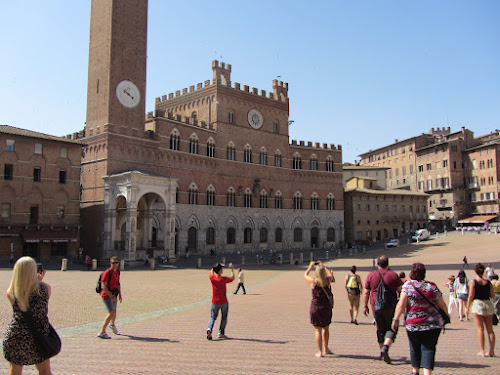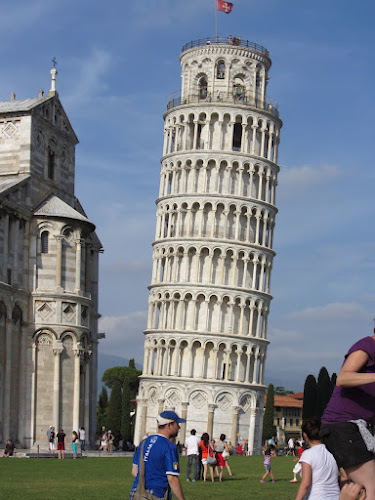There are no straight roads in Sienna. The narrow roads curve and meander. One moves over a bit as cars and scooters zip by.
For Siena we had a local guide. Donettelo, our guide, was both knowledgeable and interesting with her stories of Siena and the Italian way of life there. The city centre is a Unesco World Heritage site. The Piazzo del Campo, located at the city centre is regarded as one of Europe's greateset medieval squares. It is unique in that it is shaped like a sea shell.
Siena is renowned for its Palio - a horse race which is held twice in the summer each year. They convert the Piazza into a race track and the horses are chosen by draw to represent 10 of their 17 neighborhoods, called Contradas. In Siena, the Contrado is a source of pride and identification for those who live in the neighborhood. The rivalry between neighborhoods is settled by this race and the best Contrado, the one who wins the race, gets to celebrate all year. Apparently the town goes nuts during the 4 days of the races.
Our next stop was the Siena Cathedral or Duomo. The facade is most interesting and beautiful.
The inlaid marble mosaic floor is one of the most ornate of its kind in Italy, covering the whole floor of the cathedral. This undertaking went on from the fourteenth to the sixteenth centuries, and about forty artists made their contribution.
Our next stop was Fattoria Poggio Alloro - a Tuscan Farm and winery. We had a tour of the farm and then enjoyed a fabulous 4 course lunch with each coure paired with a wine from the winery.
The view from the farm was just spectacular. You could see San Girimaldi in the distance. Notice all the towers? That is what the town is famous for.
San Girimaldi was our next stop. This is another of the Tuscany Hill towns, which was known for it's towers. At one point there were 70 of them within the city walls. Today there are only 14 left. Our tour guide called it the Manhattan of Tuscany. In days long gone by it wasn't safe to live outside the city walls. Since the city was small, real estate was at a premium, so rather than building horizontally big houses, they built vertically big houses which looked like castle towers, but were really homes.
San Girimaldi has a thing going for it's tin man. I spotted 3 of these guys in the town. One was on top if one of the towers.
There were lots of shops selling touristy things. These stuffed wild boars were not for sale.
Can you see the tin man on top of the tower in the foreground above? I zoomed in and took the picture below.
I climbed to the high point in the village and took this photo.
Our last stop was Pisa and the Field of Miracles.
The Piazza del Duomo ("Cathedral Square") is a wide, walled area at the heart of the city of Pisa, Tuscany, Italy, recognized as one of the main centers for medieval art in the world. Partly paved and partly grassed, it is dominated by four great religious edifices: the Duomo (cathedral), the Campanile (the cathedral's free standing bell tower), the Baptistry and the Camposanto.It is otherwise known as Piazza dei Miracoli ("Square of Miracles"). This name was created by the Italian writer and poet Gabriele d'Annunzio who, in his novel Forse che si forse che no (1910) described the square in this way:L’Ardea roteò nel cielo di Cristo, sul prato dei Miracoli.which means: "The Ardea rotated over the sky of Christ, over the meadow of Miracles."
I decided a regular picture would be good enough.
Hard to believe it but we covered about 300 k in this one day of tour. I went back to Hotel Balcony tired but happy.































No comments:
Post a Comment